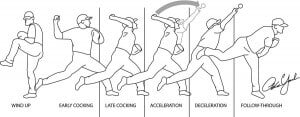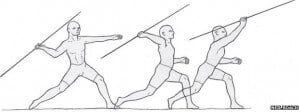Stimulus Identification is a huge part of being able to respond to it
One of the most important factors which influences Reaction Time (RT) and decision-making is the number of possible stimuli the performer must choose from at any given time – each of which may need a distinct response action to be programmed. This is the Stimulus-Response (S-R) relationship.
Choice RT in rapid, open-skill performance can be critical: in baseball for example, the entire duration of a pitch might be only 4/10s of a second (400ms) and the batter’s swing might take 120ms to execute. So if a batter, presented with multiple stimuli and uncertain which to follow, takes an extra 100ms to detect speed and trajectory of the pitch, this could leave very little time for successful contact.
Consider how Stimulus-Response might work for a staff member faced with an aggressive person who intends to harm them – they may have as little as 400ms to respond to a wild, swinging punch (which is not too dissimilar similar to the angle and trajectory of a baseball pitch).

Because Reaction Time delays can be comparitively quite long, an important strategy for open-skill performers is to find ways of decreasing the number of S-R choices they have to deal with. That means improving Stimulus Identification time.
In general, open skill performers try to find ways to decrease the number of choices they have to make so that their information-processing delay is as short as possible. An open skill is one where there are dynamic elements to both sides of the ‘play’ – and a good example is where a person is being physically assaulted and needs to respond. Applying this S-R relationship to this open skill, it is a good idea to ask: Can we train people to recognise the pre-assault mannerisms of a person who is going to punch them, shove them or kick them ?? We believe so, and the sports science research underpins this.
Research has shown that experience in recognising “ mannerisms ” or “ pre-cues ” makes a performer’s Reaction Time speed up.
“Advance information is used to speed Reaction Time” (Rosenbaum 1980).
Highly skilled performers are able to determine what is going to happen (Stimulus Identification) and when it is going to happen BEFORE it happens.
Examples from the science journals:
experienced tennis players are able to speed up their preparation for an upcoming shot by watching their opponent’s movements (Ward, Williams and Bennett, 2002)
defensive linebackers in American Football can watch the eyes of their opponents to see which way the play is going to go, anticipate the play and be ready for executing the tackle.
advanced baseball batters recognise different types of pitches faster than do intermediate-level batters (Radlo, Janelle, Barbra & Frielich, 2001)
Findings in many research experiments suggest that experienced players focus on the movements of opposing players in order to anticipate the direction of their shots (Stimulus Identification).

Could Stimulus Identification help our staff – if they could be better anticipators of imminent assaults?
Experiments have also shown that even in-experienced performers who have been given advance information, or pre-cues, about characteristics of an upcoming stimulus can reduce their choice Reaction Time. Read ‘stimulus’ in this context as ‘physical threats’ and now we have been given a hint at a training methodology to improve the performance of even in-experienced people.
Researchers assume that RT improvements happen because performers are able to organise their movements in advance by completing response-selection or response-programming activities BEFORE the stimulus is presented (Rosenbaum 1980) (Schmidt and Wrisberg 2008)
Finally it is interesting to note that If the probability of a choice stimulus is high enough, the corresponding choice RT can approximate a Simple RT.
This means that Simple (very rapid, no delay) and Choice Reaction Time (slightly delayed processing) occupy a Probability Continuum (Rosenbaum 2010). Faced with a threat, such as a punch in the face: the more probable I feel that the punch threat is going to be realised, the quicker my reaction time will be. Therefore educating staff about the identifiable cues of the most probable assaults they will face by itself may improve their Reaction Time during an incident!
What Stimulus Identification means for preparing staff for physical confrontations:
- We must include pre-assault behaviours in the design of the training experience and educate staff about the probability of different assault types (possibly by using their own organisation’s data to do so) which will aid Stimulus Identification
- We must try to improve how quickly and accurately our trainees recognise the most probable stimuli they will face, if they are physically assaulted.
- We should try to design training drills which help them to break down the mannerisms which are typical in the pre-assault phase (where aggression turns to violence) during inter-personal conflict.
- We need to look at some other factors which effect Reaction Time , and how the design and delivery of a training programme can speed Reaction Time or slow it down.
Our Breakaway Training course incorporates much of this theory and provides examples of how to incorporate good practice into training design.
You may also be interested in our post here

Gerard O’Dea is a conflict management, personal safety and physical interventions training consultant. He is the training director for Dynamis, a specialist in personal safety and violence reduction initiatives and the European Adviser for ‘Verbal Defense and Influence’, a global programme which addresses the spectrum of human conflict. www.dynamis.training



Greetings,
This is an amazing post. I wish others, in the various fields of self-protection and violence-response training would read this!
robert